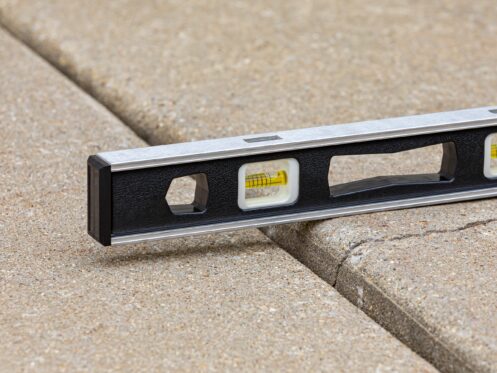Concrete surfaces can have many applications in both commercial and residential settings, such as sidewalks, driveways, foundations, and patios. They’re frequently designed to last for multiple decades but are not immune from eventual wear and tear.
With the passage of enough time, concrete might shift, settle, or crack, and the result is an uneven surface. At first glance, this is a minor inconvenience. Unfortunately, ignoring instances of uneven concrete can result in costly repairs, structural damage, and substantial safety hazards.
What Causes Uneven Concrete?
Knowing why concrete gets uneven in the first place is helpful if you want to prevent more damage. Numerous factors can contribute to this situation.
Soil Erosion and Settlement
Concrete is usually poured on top of compacted soil; however, underlying soil can start eroding over time because of plumbing leaks, water runoff, and shifting ground conditions. When the soil moves, it leaves voids underneath the concrete that can make a slap crack or sink.
Tree Roots
Trees bring beauty and shade to their landscapes and can even absorb local humidity, drop temperatures, and add property value. However, tree roots can result in severe damage to nearby concrete surfaces. When roots grow, they’ll eventually push up against concrete slabs, resulting in lifting and cracking. This happens frequently with patios, driveways, and sidewalks near large trees.
Freeze-Thaw Cycles
In regions with cold winters, water might seep into the tiny cracks of concrete slabs. The water will freeze and expand if temperatures drop enough, making these cracks wider. Repeated freezing and thawing cycles can gradually result in uneven surfaces, thanks to more serious damage.
Poor Installation
When concrete isn’t properly poured, cured, or mixed during installation, it might be more prone to uneven settling and cracking. Improper reinforcement and poor drainage can also lead to premature deterioration.
Traffic and Heavy Loads
Loading docks, parking lots, and driveways endure heavy weight and traffic loads. This constant pressure might make slabs sink, shift, or break apart in time. The result is uneven surfaces.
The Physical Consequences of Neglecting Uneven Concrete
The potential physical risks include health hazards to people, damage to homes and vehicles, and flooding in your yard.
Health Hazards
Trip and fall hazards are the first and foremost dangers involved with uneven concrete, especially for kids, seniors, and anyone with mobility issues. Voids and cracks in uneven concrete can open up entry points for rodents, ants, termites, and other pests.
Property Damage
Structural damage can happen in adjacent structures, including support beams and walls. Foundation settling is also possible and might result in misaligned windows, sticking doors, and cracked walls. Uneven concrete in garages, parking lots, and driveways can hurt vehicles by increasing wear and tear, as cracks and potholes misalign suspensions and damage tires.
Flooding
Flooding is also more likely. Water might pool in specific areas rather than drain properly, and standing water can lead to faster concrete deterioration, basement leaks, soil erosion, and mold growth.
The Financial Impact of Delayed Repairs
When you first identify uneven concrete on your property, it may need a minor fix. The price of repairs can escalate and eventually warrant full-scale reconstruction.
Legal Considerations
Liability costs and potential lawsuits are always a consideration. If someone on your property gets injured because of neglected concrete, you might face personal injury claims or have to go to court. Legal fees, medical bills, and potential settlements cost a lot more than early repairs. If you’re a landlord or business owner, you have to take even more precautions to avoid financial and legal consequences.
Insurance Premiums
Higher insurance premiums can happen if there are frequent claims related to property damage or injuries because of uneven concrete. In some instances, insurers might refuse coverage when issues are decided to be preventable hazards.
Property Value
Reduced property value can be a surprising but very real consequence of uneven or cracked concrete. Potential tenants or buyers might find the property less appealing. Real estate professionals frequently highlight well-maintained patios, sidewalks, and driveways as selling points. Alternatively, noticeable damage can hurt the curb appeal of a property and dampen its market value.
Avoid Costly Repairs With Preventative Measures
Prevention is your best course of action with concrete maintenance on your property. Being proactive means reducing the risks of expensive repairs and extending the usable lifespan of concrete surfaces.
Annual Inspections
Conduct visual inspections at least once a year for signs of sinking, cracking, or water pooling; early detection makes timely repairs possible before things get worse.
Proper Drainage
Have professionals install downspouts, gutters, and French drains to direct water away from any potentially vulnerable areas. Proper drainage prevents water-related damage and soil erosion.
Managing Trees
Plant trees at safe distances away from concrete, and use root barriers to prevent damage. Trim the roots of existing trees when necessary.
Fixing Uneven Concrete
Professionals in the concrete industry don’t just lay down new slabs. They know how to do maintenance, upkeep, diagnosis, and repairs. Uneven concrete can frequently be repaired without getting a total replacement. The best option for each situation will depend on the cause of any damage and how serious it is.
Sealing and Resurfacing
Minor unevenness can be addressed with grinding and resurfacing. Smoothing out high spots before resurfacing can result in an even and fresh layer over the existing concrete. This is commonly used for patios, sidewalks, and garage floors. Crack sealing and repair prevent future water infiltration in freeze-thaw damage cases; durable repairs are possible thanks to polyurethane and epoxy sealants.
Concrete Leveling
Concrete leveling is a process of injecting special materials underneath the concrete slab to get lifted back into its proper place. Polyjacking uses an expanding polyurethane foam, whereas mudjacking employs a mixture of cement, sand, and other various materials. Each method delivers long-lasting results in a cost-effective manner.
Total Replacement
Extensive damage might necessitate total replacement of the concrete slab. This can be the most expensive option but also presents a durable and stable surface. If you have to schedule this, plan on addressing any underlying drainage or soil issues at the same time to avoid future complications.
More Than a Minor Oversight
Neglecting concrete issues puts your household at risk for water damage, legal liabilities, and trip-and-fall accidents. The good news is that proactive maintenance and timely intervention help property owners preserve their investments while avoiding unnecessary expenses. If you or anyone else notices uneven concrete on your property, deal with it quickly.
At RhinoLift Foundation Solutions, we offer full concrete repair services to clients in Charlotte and the surrounding North Carolina communities. Our reliable foundation repair services include walls, chimneys, and piers, along with deep soil foam injection, and we also handle crawl space repairs and concrete leveling. If you need basement waterproofing, we repair, seal, and anchor walls. Contact RhinoLift Foundation Solutions to deal with uneven concrete in or around your home or business.

